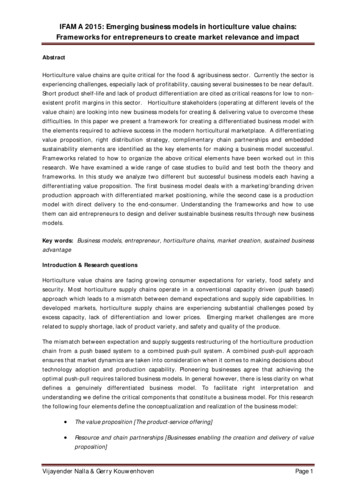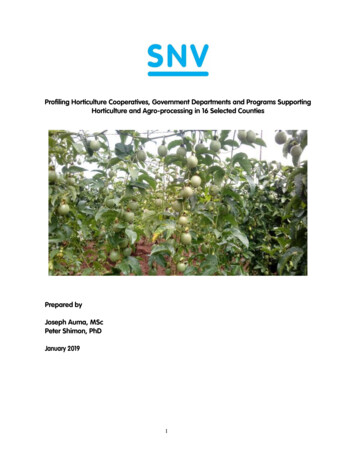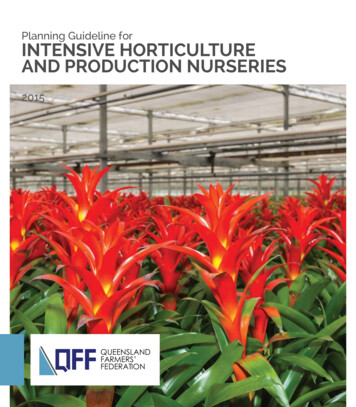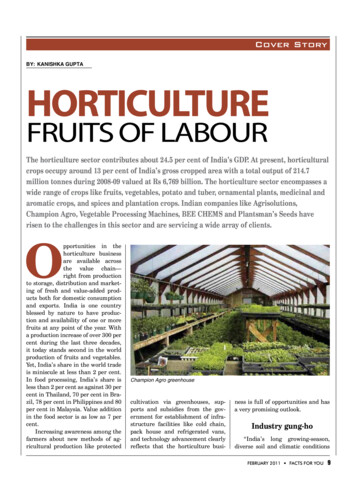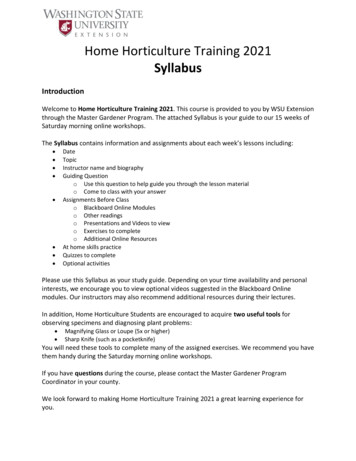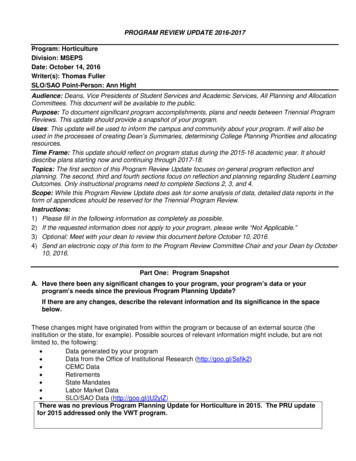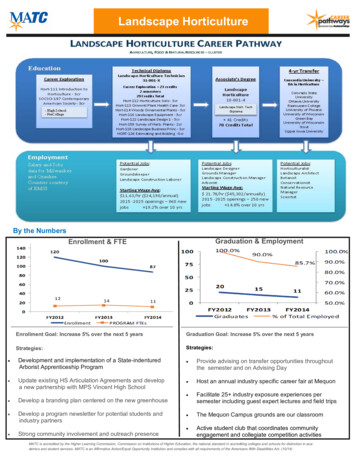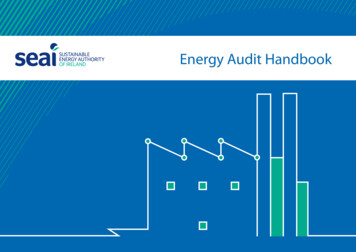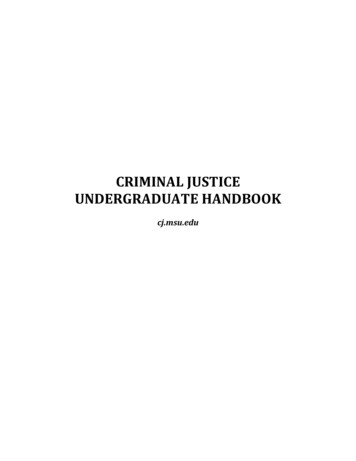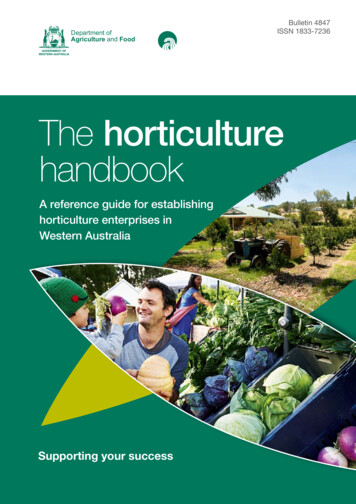
Transcription
Department ofAgriculture and FoodBulletin 4847ISSN 1833-7236The horticulturehandbookA reference guide for establishinghorticulture enterprises inWestern AustraliaSupporting your success
DISCLAIMERThe Chief Executive Officer of the Department of Agricultureand Food and the State of Western Australia accept noliability whatsoever by reason of negligence or otherwisearising from the use or the release of this information or anypart of it.3 Baron-Hay Court South Perth WA 6151Tel: 61 (0)8 9368 3333Email: enquiries@agric.wa.gov.auagric.wa.gov.auCopyright Western Australian Agriculture Authority, 2014
Bulletin 4847ISSN 1833-7236April 2014The horticulturehandbookA reference guide for establishinghorticulture enterprises inWestern Australia
ContentsIntroduction. . . . . . . . . . . . . . . . . . . . . . . . . . . . . . . . . . . . . . . . . . . . . . . . . . . . . . . . . . 3Acknowledgements . . . . . . . . . . . . . . . . . . . . . . . . . . . . . . . . . . . . . . 3Horticulture checklist. . . . . . . . . . . . . . . . . . . . . . . . . . . . . . . . . . . . . . . . . . . . . . . . 4Part A: Regulations and licences . . . . . . . . . . . . . . . . . . . . . . . . . . . . 4Part B: Crop requirements . . . . . . . . . . . . . . . . . . . . . . . . . . . . . . . . . 8Part C: Budgets and marketing . . . . . . . . . . . . . . . . . . . . . . . . . . . . 11Horticulture — for fun, profit or ruin?. . . . . . . . . . . . . . . . . . . . . . . . . . . . . 151.The major issue: water availability. . . . . . . . . . . . . . . . . . . . . . 152.Key issues: water, market, climate, labour and soils . . . . . . . 153.Other important issues . . . . . . . . . . . . . . . . . . . . . . . . . . . . . . 254.Growing for profit . . . . . . . . . . . . . . . . . . . . . . . . . . . . . . . . . . 285.Comments on selected crops. . . . . . . . . . . . . . . . . . . . . . . . . 306.Tax matters. . . . . . . . . . . . . . . . . . . . . . . . . . . . . . . . . . . . . . . 39Guide to legislation. . . . . . . . . . . . . . . . . . . . . . . . . . . . . . . . . . . . . . . . . . . . . . . . . 40Overview. . . . . . . . . . . . . . . . . . . . . . . . . . . . . . . . . . . . . . . . . . . . . . 401.Planning controls. . . . . . . . . . . . . . . . . . . . . . . . . . . . . . . . . . . 412.Land clearing controls. . . . . . . . . . . . . . . . . . . . . . . . . . . . . . . 443.Pollution controls. . . . . . . . . . . . . . . . . . . . . . . . . . . . . . . . . . . 464.Drainage and pumping controls . . . . . . . . . . . . . . . . . . . . . . . 495.Water licences . . . . . . . . . . . . . . . . . . . . . . . . . . . . . . . . . . . . 526.Fire control measures. . . . . . . . . . . . . . . . . . . . . . . . . . . . . . . 537.Property access/egress controls. . . . . . . . . . . . . . . . . . . . . . 548.Flora/fauna controls . . . . . . . . . . . . . . . . . . . . . . . . . . . . . . . . 559.Handling and applying chemicals. . . . . . . . . . . . . . . . . . . . . . 56References . . . . . . . . . . . . . . . . . . . . . . . . . . . . . . . . . . . . . . . . . . . . 59Contact details . . . . . . . . . . . . . . . . . . . . . . . . . . . . . . . . . . . . . . . . . . . . . . . . . . . . . 60HOME2
IntroductionThe Department of Agriculture and Food, Western Australia (DAFWA)assists WA’s 6 billion agriculture and food sector to be sustainable andprofitable, with a clear focus on export-led growth.Our department’s vision is: “a progressive, innovative and profitableagriculture and food sector that benefits Western Australia”. Our role asan economic development department is about supporting the successof, and creating value for, businesses all along the supply chain.The horticulture handbook has been developed by the DAFWA SmallLandholder Information Service (SLIS). This handbook is designedto acquaint landholders and potential investors with the regulations,requirements and considerations necessary to develop a block of land forhorticulture in WA.High prices, climate suitability and identified market opportunities makesome horticultural crops appear an attractive investment. Before decidingto invest it is important to research a crop thoroughly from productionplanning all the way to the consumer. Thorough investigation will reveal acrop’s true potential and help you make the best decision.The horticulture handbook is a valuable guide, which includes a checklistand sections on regulations, key issues, production and marketing costsand approvals, along with a list of references and useful contacts.The handbook is an excellent source of information designed to assistyou to successfully establish a new horticultural business in WA.Neil GuiseRegional Director, South West Agricultural RegionApril, 2014AcknowledgementsThis publication would not have been possible without the cooperation ofofficers from across the Western Australian government departments andagencies.Special thanks to staff from the Department of Agriculture and Food,Department of Environment Regulation, Department of Health,Department of Planning and Department of Water for the original content.Reviewed and updated by Jodie Bowling, Martine Combret, James Dee,Farran Dixon, Richard Fennessy, Alec McCarthy, Heather Percy, RohanPrince, Helen Newman, Peter Tille, Leon van Wyk and Andrew Watson,Department of Agriculture and Food Western Australia. Also reviewed andupdated by the Department of Environment Regulation and Main RoadsWestern Australia.HOME3
H o r t i c u l t u r e c he c kl i stHorticulture checklistHorticulture checklistThis checklist is designed to get you thinking about some of the importantthings to consider before embarking on a horticultural venture.By considering questions and cross checking actions, potential investorscan increase the likely success and profitability of their new business.Detailed information, tips and pointers are included to help potentialinvestors answer the questions within the checklist.There are two ways to approach investment in horticulture. One is toidentify market opportunities before considering the purchase of suitableland. The other approach is to identify opportunities to utilise an existingarea of land. This checklist starts with the assumption that you own, or haveyour eye on, a particular parcel of land.The checklist is presented in three parts:Part A:Regulations that apply to the use of land and licences you mayneed to develop a block for horticulture.Part B:Crop requirements — suitability of local climatic conditions, soiltype and water source.Part C:Production and marketing costs and considerations.Use the boxes beside each action to keep track of what you have and havenot considered.Part A: Regulations and licencesAre there any local, regional or state planning regulationsconcerning horticultural activities on the proposeddevelopment site?To avoid conflict between different land uses and to support horticulturaldevelopment in priority areas, there may be regulations in place that restrictor promote horticultural activity on the site.Certain developments or changes in land use listed under local or regionalplanning schemes will require approval. Failure to obtain approval wherenecessary is an offence.Action:Read Guide to legislation, section 1 (see page 41).Check with your local government authority (LGA) forpossible controls on horticultural developments, includingminimum setback regulations, bans on the use of particularchemicals and bans on the use of manures.Ask your LGA planning department if there are any otherregional or state planning policies or schemes concerninghorticultural activity on the site.HOME4
Ho r t icult ur e che c k l i s tDo you need to clear land?Permits from the Department of Environment Regulation (DER) andpotentially your LGA are required to clear land. It is important toinvestigate the legalities and environmental impact of any land clearingbefore planning further development.Information on land clearing, including application forms, fact sheets andguides can be found on the DER website.In reviewing proposals, the principles contained in Schedule 5 of theEnvironmental Protection Act 1986 (EP Act) and also any planninginstrument or other relevant matter are considered. The clearing principlesconsider environmental impacts on biodiversity values, water quality andland degradation. Clearing that significantly impacts on the environmentis generally not supported. The DER native vegetation fact sheet 1 Nativevegetation clearing legislation in Western Australia, outlines the intent ofthe clearing legislation in more detail.Action:Read Guide to legislation, section 2 (see page 44).Contact your LGA and DER offices to discuss yourclearing proposal.HOME5
H o r t i c u l t u r e c he c kl i stDo you need to drain or pump water to manage salinityor waterlogging?Landholders intending to drain or pump groundwater for the purpose ofcontrolling salinity must submit a ‘notice of intent to drain’ application tothe Department of Agriculture and Food, Western Australia (DAFWA) atleast 90 days before the commencement of works.Landholders within the Peel-Harvey Catchment must notify DAFWA forany works involving the draining of surface water or groundwater.The notification process allows for an assessment of the proposed worksand ensures neighbouring landholders and affected public authoritieshave an opportunity to comment on the proposal.DAFWA will generally object to works likely to cause onsite or offsite landdegradation.Failure to give notice is an offence and can expose the offender to anoffence of causing serious or material environmental harm.Action:Read Guide to legislation, section 4 (see page 49).Contact your LGA and DAFWA offices to discuss youroptions and to lodge a notification.Could your activities be a source of a conflict (dust, noise, spraydrift, pollution, odours, etc.) with your neighbours?There may be conflicting activities between you and your neighbours.These conflicts may result in expensive damages or inconvenience.Action:Read Guide to legislation, section 3 (see page 46).Identify the other land uses in the surrounding area andconsider the impact they may have on your proposedoperation and the impact your operation may have onothers. This is particularly important when establishing anew type of horticultural enterprise.There may also be features of environmental significanceto consider, such as lakes, rivers or rare plants locatednear your site. Contact your LGA, DER offices orcatchment council to determine if this is the case, orfor advice.HOME6
Ho r t icult ur e che c k l i s tDo you have access to water?Scheme water is usually too expensive to use for commercial horticulture.Water sourced from a bore, soak, stream, dam or irrigation scheme isoften required.The amount of water you can access will determine the type of crop youcan grow and/or the area of crop you can plant.You need to know how much water you can access in totaleach year.Licences that allow you to take water from non-scheme sources inproclaimed areas, irrigation districts and prescribed areas are allocatedby the Department of Water (DoW) under the Rights in Water andIrrigation Act (RIWI Act) 1914. Water allocations are calculated accordingto the area of land planted, crop type, local evaporation rates and waterresource availability in the area.Groundwater resources are often allocated in kilolitres per hectare peryear (kL/ha/y).Action:Read Horticulture, section 1 (see page 15) and section2.1.2 (see page 18) and Guide to legislation, section 5 (seepage 52).Contact the DoW or your local irrigation scheme forinformation on water availability on your property.A licence from the DoW is required to access all non-schemesurface and groundwater resources, including water frombores, soaks and streams. Developments inside declared watercatchment and water reserve areas also require DoW approval.HOME7
H o r t i c u l t u r e c he c kl i stPart B: Crop requirementsHow much water does the crop require?How much water a crop requires each day throughout the year willdetermine the area of crop you can plant using the available water.DAFWA has developed an online irrigation calculator to help determinemonthly and annual crop water requirements. The calculator providesinformation on a range of crops under different management strategies orseasonal planting scenarios at 14 locations throughout WA.The total amount of water required is calculated using recent historicalweather data and the evaporation replacement requirement of specificcrops, called ‘crop factors’, with adjustments made for planting date, soiltype, irrigation system and efficiency.For further information read: Noteworthy 41 — Waterwise irrigation – big benefits for smallpropertiesAction:Read Horticulture, section 2.1.2 (see page 18).Check your crop’s water requirements with DAFWA’sonline irrigation calculator at irrigationcalculator.comWhat is the quality of the available water?Water quality affects the type of crops you can grow, the type of irrigationsystem and filtering systems you require and how you manage yourirrigation.Action:Read Horticulture, section 2.1.1 (see page 17).Have the quality of your water source laboratory-testedbefore deciding what crop to grow and what irrigationsystem to use.Test the water for pH, salt (electrical conductivity: EC),sodium absorption ratio (SAR), chloride, iron and calciumlevels. Other water quality measures to consider arebiological and nutrient contamination.HOME8
Ho r t icult ur e che c k l i s tCan your water source deliver enough water during peakdemand periods?Peak daily water requirements occur in most crops when evaporationrates are at their highest during summer or the dry season. If a crop’swater requirements are not met each day, quality and yield will decline.To produce economical yields and marketable quality produce, climaticconditions must match crop requirements.Climatic conditions, such as light availability, evaporation rates, wi
horticulture handbook is a valuable guide, which includes a checklist and sections on regulations, key issues, production and marketing costs and approvals, along with a list of references and useful contacts. The handbook is an excellent source of information designed to assist you to successfully establish a new horticultural business in WA.File Size: 2MBPage Count: 64
